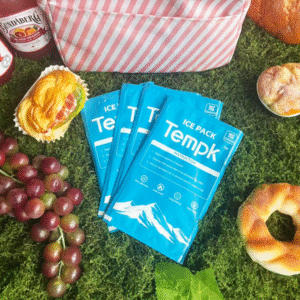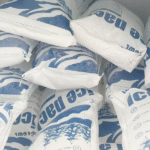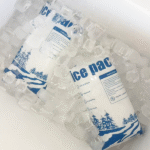Expédition mondiale de glace carbonique et de packs de glace: Le guide ultime pour 2025
Expédition de marchandises sensibles à la température comme les produits pharmaceutiques, nourriture, et les échantillons biologiques nécessitent un emballage spécialisé et le respect des réglementations mondiales. La glace carbonique et les blocs réfrigérants sont deux des agents de refroidissement les plus fiables pour de tels envois.. Ce guide couvre les informations essentielles sur l'expédition dans le monde entier avec Packs de glace sèche et de glace, y compris les meilleures pratiques, avantages, et le dernier 2025 tendances.
-
Qu'est-ce que la glace carbonique, et comment ça marche pour l'expédition?
-
Quelles sont les principales différences entre la glace carbonique et les blocs réfrigérants pour les expéditions mondiales?
-
Quelles sont les meilleures pratiques pour expédier de la neige carbonique et des blocs de glace dans le monde entier?
-
Comment l'utilisation de glace carbonique et de blocs réfrigérants peut-elle être bénéfique pour votre entreprise?
-
Quelles sont les dernières tendances en matière d'expédition de glace carbonique pour 2025?
Qu'est-ce que la glace carbonique et comment fonctionne-t-elle pour l'expédition dans le monde entier?
La glace sèche est la forme solide de dioxyde de carbone (CO2), qui sublimate (passe directement du solide au gaz) à -78,5 ° C (-109.3°F). Contrairement à la glace ordinaire, La glace sèche ne fonde pas dans l'eau, ce qui le rend parfait pour expédier des articles sensibles à la température sans risque de dégâts d'eau. Il absorbe la chaleur de son environnement, créer un environnement à basse température qui aide à maintenir la température requise pour les marchandises périssables pendant le transport.
Pourquoi devriez-vous utiliser de la glace carbonique pour vos expéditions dans le monde entier?
La glace carbonique est particulièrement utile lors de l'expédition de produits qui doivent rester congelés.. Il offre plusieurs avantages aux entreprises:
-
Contrôle de température cohérent: La glace carbonique maintient une température basse et constante pendant de plus longues périodes par rapport à la glace ordinaire, Réduire les risques de détérioration.
-
Pas de dégâts d'eau: Depuis la glace sèche sublimate, il n'y a aucun risque de dégâts des eaux sur les marchandises, ce qui est particulièrement crucial pour les produits pharmaceutiques et alimentaires.
-
Compatibilité mondiale: La glace carbonique est largement acceptée pour le transport maritime international, garantir que les produits restent dans les plages de température requises lors des expéditions longue distance.
Que sont les packs de glace, et quand devriez-vous les utiliser?
Les blocs de glace sont remplis de gel ou de liquides de refroidissement à base d'eau qui gèlent à des températures spécifiques., généralement autour de 0°C (32°F). Ils conviennent aux articles qui doivent rester frais mais pas congelés., comme les chocolats, produits frais, et produits pharmaceutiques qui ne doivent pas geler.
Pourquoi choisir des packs de glace?
-
Moins de complexité réglementaire: Les blocs de glace ne sont pas classés comme matières dangereuses, ils nécessitent donc moins de réglementations que la neige carbonique.
-
Idéal pour les durées plus courtes: Les blocs réfrigérants conviennent aux expéditions plus courtes et aux produits nécessitant une réfrigération plutôt que la congélation..
Meilleures pratiques pour l’expédition de glace carbonique et de packs de glace
Emballage et ventilation
Un emballage approprié est essentiel pour la glace carbonique et les blocs de glace. Utilisez toujours conteneurs isolés conçu pour maintenir des températures basses et permettre une ventilation adéquate. Pour la glace carbonique, l'emballage doit permettre au gaz CO2 de s'échapper pour éviter l'accumulation de pression, tandis que les contenants de glace doivent être scellés pour éviter les fuites.
Comprendre les limites de poids de la glace carbonique
Différents pays ont des réglementations différentes concernant les expéditions de glace carbonique. Typiquement, jusqu'à 5.5 livres (2.5 kg) de glace carbonique peut être expédiée dans un seul colis. Vérifiez toujours les réglementations locales pour garantir leur conformité.
Étiquetage correct
Les expéditions de glace carbonique et de blocs de glace nécessitent un étiquetage précis. Les expéditions de glace carbonique doivent être marquées “Glace sèche” ou “Dioxyde de carbone, Solide” et le approprié Et 1845 nombre. Incluez le poids de la neige carbonique et tous les symboles de danger requis.
Consignes de sécurité et de manipulation
-
Glace sèche: Manipulez toujours la glace carbonique avec des gants isolants pour éviter les engelures. Assurez-vous que les conteneurs sont ventilés pour permettre au gaz CO2 de s'échapper en toute sécurité.
-
Packs de glace: Les blocs de glace sont plus faciles à manipuler mais doivent être conservés dans un emballage étanche pour empêcher l'eau de s'infiltrer sur les marchandises..
Comment l’expédition de glace carbonique et de packs de glace profite à votre entreprise
L'utilisation de neige carbonique et de blocs réfrigérants peut grandement améliorer l'efficacité de vos opérations.. Voici comment:
Qualité des produits améliorée
L'expédition avec de la neige carbonique garantit que les produits tels que les aliments surgelés, échantillons biologiques, et les vaccins restent à la température requise, éviter leur détérioration et préserver leur qualité.
Extension des offres de services
En intégrant l'expédition de glace carbonique et de blocs de glace, votre entreprise peut se développer sur de nouveaux marchés qui exigent des expéditions sensibles à la température, comme les industries pharmaceutiques ou biotechnologiques.
Amélioration de la satisfaction du client
La rapidité et l’efficacité sont essentielles sur le marché actuel. En proposant une expédition fiable de glace carbonique et de blocs de glace, vous pouvez répondre aux demandes des clients en matière de livraison rapide sans compromettre la qualité du produit.
2025 Tendances en matière d’expédition de glace carbonique et de blocs de glace
L'industrie de la logistique de la chaîne du froid évolue rapidement, et voici quelques tendances clés:
Emballage et surveillance intelligents
Les technologies d'emballage intelligentes permettent une surveillance en temps réel des fluctuations de température, humidité, et niveaux de CO2 pendant le transport. Ces innovations aident les entreprises à optimiser leur logistique sous chaîne du froid pour une plus grande efficacité.
Solutions d'expédition durables
Alors que la demande de pratiques respectueuses de l’environnement augmente, de plus en plus d'entreprises adoptent des matériaux d'emballage durables pour les expéditions de glace carbonique et de blocs de glace. Cela inclut les matériaux biodégradables et les liquides de refroidissement réutilisables.
Partenariats mondiaux de transport maritime
Dans 2025, les entreprises s'associent de plus en plus à des prestataires logistiques spécialisés dans les solutions de chaîne du froid, ce qui permet des expéditions internationales plus sûres et plus efficaces.
FAQ courantes sur l'expédition de glace carbonique et de blocs de glace
Q1: Puis-je utiliser de la neige carbonique pour expédier des marchandises périssables?
Oui, la glace carbonique est parfaite pour expédier des marchandises périssables qui doivent rester congelées, comme les vaccins, fruit de mer, et produits alimentaires surgelés.
Q2: Les packs de glace nécessitent-ils une documentation spéciale pour l'expédition internationale?
Non, les blocs de glace ne sont pas classés comme matières dangereuses, ils ne nécessitent donc pas la documentation complexe que nécessite la glace carbonique.
Q3: Comment puis-je m'assurer que mes expéditions de neige carbonique restent dans la plage de température requise?
Assurer un emballage approprié, vérifiez les réglementations locales pour connaître les limites de poids, et incluez toujours une ventilation adéquate pour les expéditions de glace carbonique.
Résumé et recommandations
Pour expédier avec succès de la neige carbonique et des blocs de glace dans le monde entier, il est essentiel de suivre les bonnes pratiques en matière d’emballage, étiquetage, et conformité réglementaire. Ces méthodes garantissent non seulement une expédition sûre et efficace, mais aident également votre entreprise à élargir ses offres de services et à améliorer la satisfaction de ses clients..
À propos du tempk
Et tempk, nous sommes spécialisés dans les solutions logistiques à température contrôlée, garantir une expédition sûre et conforme des marchandises sensibles à la température. Notre expertise en matière de systèmes de glace carbonique et de blocs de glace aide les entreprises à naviguer dans les complexités de la logistique mondiale de la chaîne du froid..
Prêt à optimiser vos opérations de chaîne froide? Contactez Tempk dès aujourd'hui pour obtenir des conseils d'experts et des recommandations personnalisées sur l'expédition de glace carbonique et de blocs de glace..
























